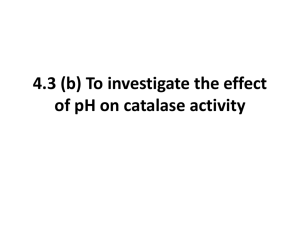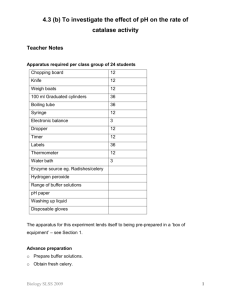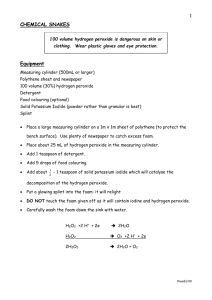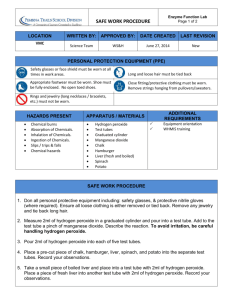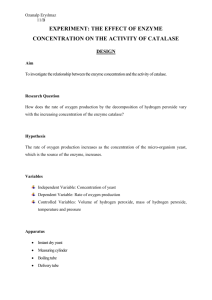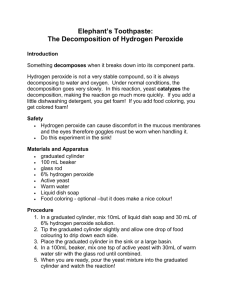Catalase Teacher`s notes
advertisement
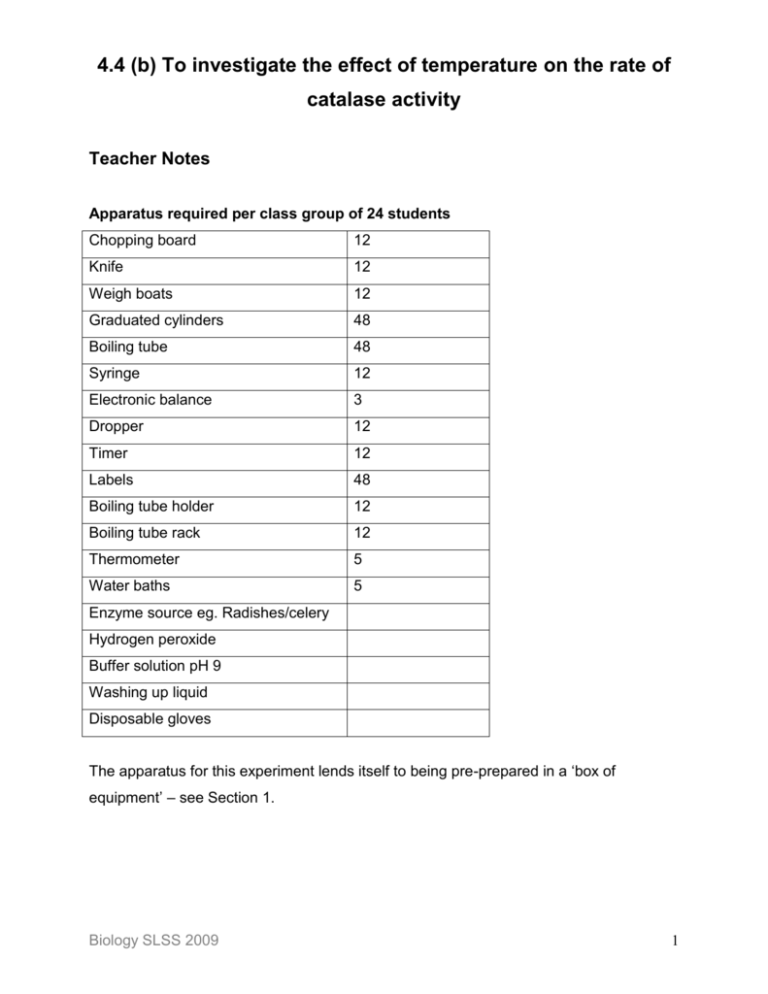
4.4 (b) To investigate the effect of temperature on the rate of catalase activity Teacher Notes Apparatus required per class group of 24 students Chopping board 12 Knife 12 Weigh boats 12 Graduated cylinders 48 Boiling tube 48 Syringe 12 Electronic balance 3 Dropper 12 Timer 12 Labels 48 Boiling tube holder 12 Boiling tube rack 12 Thermometer 5 Water baths 5 Enzyme source eg. Radishes/celery Hydrogen peroxide Buffer solution pH 9 Washing up liquid Disposable gloves The apparatus for this experiment lends itself to being pre-prepared in a ‘box of equipment’ – see Section 1. Biology SLSS 2009 1 Advance preparation o Prepare buffer solution pH 9. o Obtain fresh celery. o Set up water baths and check temperatures with a thermometer. Advance chemical preparation (a) Hydrogen peroxide (Prepares 250 ml of 1M/’12 vol’ solution) o Wearing gloves, measure out 29 ml of ‘100 vol’ hydrogen peroxide into a measuring cylinder. o Make up to 250 ml with water, add to a labelled bottle and mix well. o Alternatively, small quantities of hydrogen peroxide can be purchased in the local pharmacy. Safety precautions o Hydrogen peroxide is both oxidising and corrosive. For further information see MSDS. Expected outcome of experiment o Catalase from celery has an optimum temperature of 20OC. This temperature should result in the greatest volume of foam produced. o At temperatures above and below 20OC, the activity of catalase decreases, less foam will be produced. Disposal and post-experiment work o To dispose of hydrogen peroxide, add small quantities (100ml) in 10L of water and run to foul water drain. Biology SLSS 2009 2 4.4 (b) To investigate the effect of temperature on the rate of catalase activity Student Notes Apparatus required per group o Chopping board o Boiling tube holder o Knife o Boiling tube rack o Weight boat o 4 x Labels o 4 x Graduated cylinders o Thermometer o 4 x Boiling tubes o Water baths o Syringe o Celery o Electronic balance o Hydrogen peroxide o Dropper o Buffer solution pH 9 o Timer o Washing-up liquid o Disposable gloves Assembled apparatus Biology SLSS 2009 3 Method 1. Add 20 ml of one of the selected buffers to a graduated cylinder. 2. Using a dropper, add one drop of washing-up liquid to the graduated cylinder. 3. Add 5g of finely chopped celery to the cylinder. 4. Add 2 ml of hydrogen peroxide to a boiling tube. 5. Stand the cylinder and the boiling tube in an ice-cold water bath until the desired temperature (4OC) is reached in both. 6. Pour the hydrogen peroxide into the cylinder. 7. Note the volume in the cylinder immediately and record. 8. Read the volume again after a measured amount of time, e.g. 2 minutes, and record. 9. Subtract the initial volume from the final volume to get the volume of foam and record. 10. Repeat the procedure from step 1 for at least four more temperatures, to include a sample in the 50OC – 60OC range. 11. A graph should be drawn of enzyme activity (volume of foam after 2 minutes) against temperature. Put temperature on the horizontal axis. 12. At the end of the experiment, clean all of the equipment and replace it in its correct place. Results: Temperature (OC) Initial volume (ml) Final volume (ml) Volume of foam produced (ml) Conclusion/Comment Biology SLSS 2009 4
